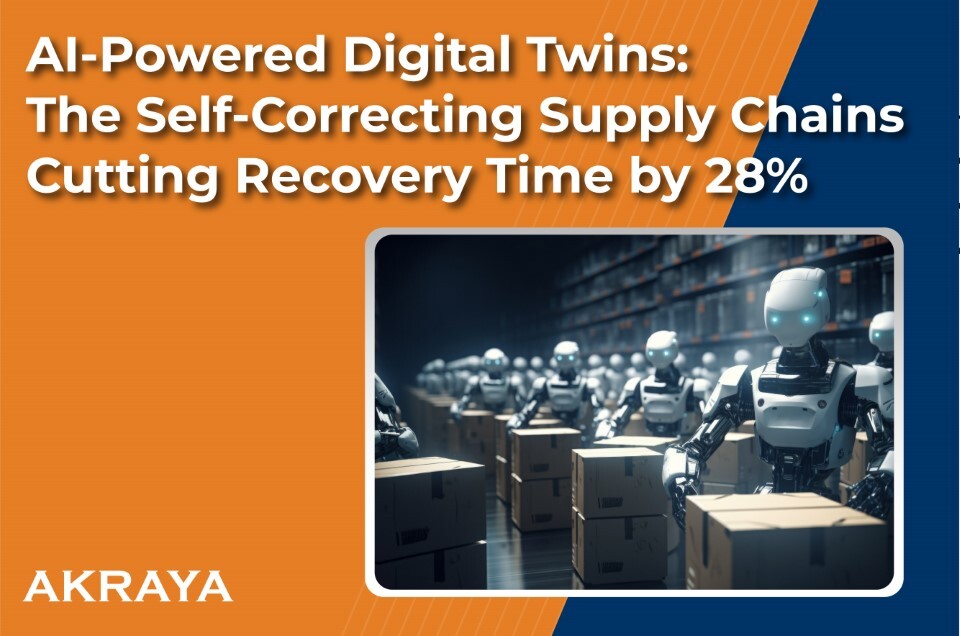Why UX Research Is the Secret Weapon of Successful Product Teams
Why UX Research Is the Secret Weapon of Successful Product Teams
2 min read
Rinki Yumnam : November 18, 2025

Every supply chain leader wants the same two things: stability and speed. But with market volatility, unpredictable disruptions, and rising operational costs, achieving both feels like chasing a moving target. Enter the next big shift in supply chain modernization: AI powered digital twins. This real time, self-adjusting virtual replicas are rewriting the rules of supply chain performance.
Digital twins used to be expensive prototypes and simulation tools, but the rise of AI has transformed them into full scale decision engines. They now monitor, predict, and respond to operational shifts faster than human teams can process information. The result is simple but powerful: supply chains that can adjust on their own before issues turn into failures.
What Digital Twins Really Do in a Modern Supply Chain
An AI driven digital twin continuously mirrors your actual supply chain, pulling data from systems, workflows, inventory, logistics, and external signals. This real time mapping allows the model to flag risks early, suggest corrective actions, and simulate outcomes before leaders need to decide.
In practice, digital twins become a second brain for operations. They surface demand anomalies, identify bottlenecks, recommend alternative routing, highlight capacity concerns, and test the impact of changes before a single real-world adjustment happens.
Supply chains in 2025 are dealing with new pressure points. Inventory complexity is increasing, global disruptions remain unpredictable, and data is coming in faster than teams can analyze. Digital twins bring clarity and control in moments where visibility and response speed matter most.
Organizations that deploy digital twins report sharper visibility and shorter recovery windows during disruptions, increasing resilience across their entire operating model.
The Impact: Recovery Time Drops by 28 Percent
SCMR reports that Gartner’s 2025 Resilience Benchmark shows companies that integrate AI-powered digital twins within their supply chains achieve recovery 28% faster following disruptions. These systems not only forecast potential issues but also independently adjust logistics and operations, helping to shorten recovery intervals after events such as supply bottlenecks or natural disasters.
When a supply chain issue hits, the first question is always the same: how long will recovery take? AI powered digital twins significantly reduce this window. Modelling, predicting, and testing solutions in real time leads to faster pivots and cleaner decision making, cutting recovery time by up to 28 percent.
That number reflects more than speed; it reflects confidence. When teams know the system is already analysing the risk and recommending fixes, their focus shifts from firefighting to optimizing.
Risks and Challenges Leaders Must Consider
Digital twin success is not guaranteed. Many organizations stumble because their data is fragmented, inconsistent, or not flowing in real time. AI powered twins need connected systems to function. Common challenges include:
Without addressing these fundamentals, a digital twin becomes just another dashboard with no real intelligence or agility.
Strong digital twin programs follow the same foundational principles:
Digital twins do not replace people. They multiply the capability of the people who already understand your supply chain.
AI powered digital twins are no longer emerging technology. They are becoming core infrastructure for modern supply chain operations. Organizations that build self-correcting, predictive, and adaptive supply chains gain an advantage that is almost impossible to compete with.
At Akraya, we help enterprises strengthen their supply chain transformation goals by providing teams skilled in AI, data engineering, automation, and predictive analytics. Whether you are modernizing your supply chain systems or building a digital twin roadmap, our managed teams and staffing solutions ensure you have the right expertise to scale with confidence.
Explore how our Supply Chain Talent Solutions and Managed Services teams can support your transformation journey. Reach out to us today

Akraya transformed application infrastructure into a $900M+ revenue accelerator, enabling scalable growth and future-proofing against next-gen demands.

Akraya’s talent-on-demand strategy transformed merchandising into a predictive revenue engine, driving $8.4B in new sales and enabling the most responsive omnichannel system in the industry.

Why UX Research Is the Secret Weapon of Successful Product Teams

In the past few years, global supply chains have gone from “just in time” to “just barely holding on.” Between unpredictable demand, labor shortages,...

How to Build a Roadmap for Your Supply Chain Digital Transformation Why Digital Transformation Can No Longer Wait